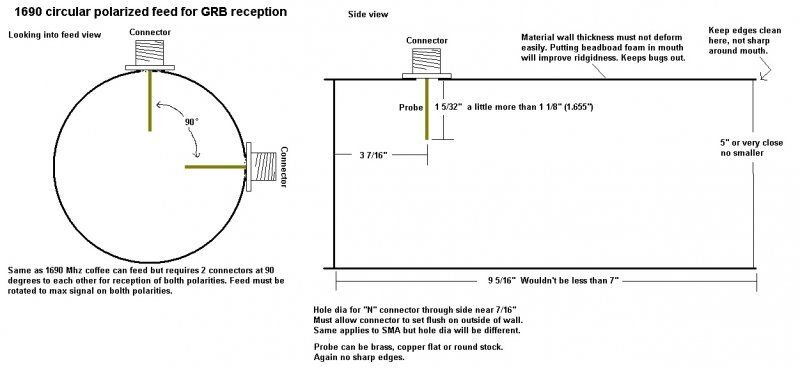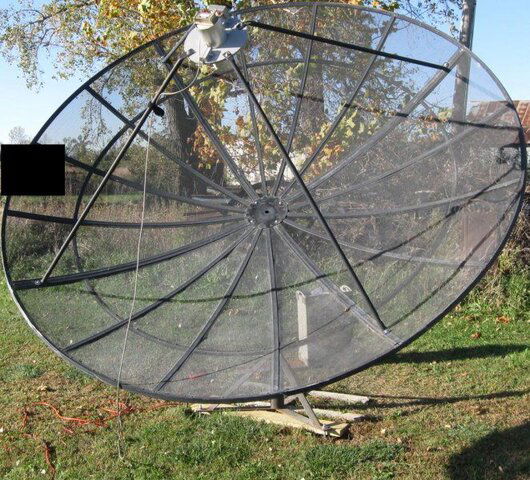Well it 3 AM CST and I figure lets bring up a thread on the new GOES 16 GRB info or GVAR as well. First off I have talked on here about EMWIN several times so some of you may know me already. For those of you who don't I will give you some info. I receive 3 weather data downlinks here. 1. EMWIN N ,2. GVAR ,3. NOAAPORT. EMWIN on an 8' dish, GVAR on a 12' dish and NOAAPORT on a 10' dish. I see most discussions on EMWIN or a few on NOAAPORT so I wanted to bring up one on GVAR or GRB. Okay, GVAR this is a 4 MHZ wide BPSK signal transmitting the GOES East or GOES West processed sensor data for the imager and sounder. The data rate is 2.11 MBPS. The format is a variable gridded style that most don't have the software to plot or display. Since the signal comes down on the L band at 1685.7 Mhz the hardware is not at all common for reception for this data. What does all the above mean, expensive $$$ to build a ground station. Mine is a commercial one and it wasn't cheap though it could have been even more $$$ then what I payed. It also requires no less then a 10' dish for adequate reception 12' if you want a couple of DB of margin. I'm shure the neighborhood covenants allow this size of dish in the yard....No. Since NOAAPORT was converted to a DVBS-2 format the price for these stations have dropped in a major way. Here's why NOAAPORT used to be transmitted on the C BAND (and still is) with a BPSK modulation and it had 4 channels, so you had to have to have 4 receivers to get all of what it had to offer. I had an old style NOAAPORT station quoted and is was 100k + for one, Wayy out of most's price range. When DVBS-2 came along the hardware costs went way down and most could build one. Along with the hardware costs coming down software that was affordable came on the market to decode the frames coming from the DVBS-2 receiver. This software I currently use (weather message). As with the same for EMWIN, since the coming along with SDR's the hardware costs are plummeting for a ground station. Where am I going with all this. I am making the attempt to build a GRB downlink with commercial available hardware and software that is available on the internet to decode the GRB frames. The great thing about GRB is that it's a DVBS-2 format so the receiver is readily available on the market. Next the software is available to decode the frames and turn the packets into NETCDF-4 files. The not so great part is that since the ABI is transmitting much more data it requires a wider bandwidth, how wide you ask? how about 10 Mhz wide. With the wider band a reduction in transmitter power may be an issue. The current GOES 16 antenna sold is a 4.5 meter dish, Pretty much a 15' dish, you turn heads and cars slow down with a dish that size in your yard.
Since NOAAPORT was converted to a DVBS-2 format the price for these stations have dropped in a major way. Here's why NOAAPORT used to be transmitted on the C BAND (and still is) with a BPSK modulation and it had 4 channels, so you had to have to have 4 receivers to get all of what it had to offer. I had an old style NOAAPORT station quoted and is was 100k + for one, Wayy out of most's price range. When DVBS-2 came along the hardware costs went way down and most could build one. Along with the hardware costs coming down software that was affordable came on the market to decode the frames coming from the DVBS-2 receiver. This software I currently use (weather message). As with the same for EMWIN, since the coming along with SDR's the hardware costs are plummeting for a ground station. Where am I going with all this. I am making the attempt to build a GRB downlink with commercial available hardware and software that is available on the internet to decode the GRB frames. The great thing about GRB is that it's a DVBS-2 format so the receiver is readily available on the market. Next the software is available to decode the frames and turn the packets into NETCDF-4 files. The not so great part is that since the ABI is transmitting much more data it requires a wider bandwidth, how wide you ask? how about 10 Mhz wide. With the wider band a reduction in transmitter power may be an issue. The current GOES 16 antenna sold is a 4.5 meter dish, Pretty much a 15' dish, you turn heads and cars slow down with a dish that size in your yard. I have been told that it possible to get it on a 12' dish here in the midwest and that is what I want to find out. Since the L band is within the DVBS-2 receiver range no downconverter is needed however the receiver must be mounted close to the antenna as the 1686.6 Mhz signal is very lossy on any type of reasonable transmission line but waveguide. Once the signal is at the receiver it turned into ethernet packets and sent to the processing computer where the software does the rest. This in terms is a very simple setup compared to what is currently. But if I can't get enough signal then the rest is mute. GRB is a circular polarized signal as there are bolth horizontal and vertical coming from the transmitter. I am interested only in the vertical side as it has the imager data I want. Perhaps receiving the one polarization will give a little extra to make the 12' dish work. Anyway that's my attempt. Some of the data above may be inaccurate as I'm doing all this from memory tonight. Through in your 2 cents and mabie I'll find out something that I didn't know before. Also I am including an image of the two moreso the GRB data info.
I have been told that it possible to get it on a 12' dish here in the midwest and that is what I want to find out. Since the L band is within the DVBS-2 receiver range no downconverter is needed however the receiver must be mounted close to the antenna as the 1686.6 Mhz signal is very lossy on any type of reasonable transmission line but waveguide. Once the signal is at the receiver it turned into ethernet packets and sent to the processing computer where the software does the rest. This in terms is a very simple setup compared to what is currently. But if I can't get enough signal then the rest is mute. GRB is a circular polarized signal as there are bolth horizontal and vertical coming from the transmitter. I am interested only in the vertical side as it has the imager data I want. Perhaps receiving the one polarization will give a little extra to make the 12' dish work. Anyway that's my attempt. Some of the data above may be inaccurate as I'm doing all this from memory tonight. Through in your 2 cents and mabie I'll find out something that I didn't know before. Also I am including an image of the two moreso the GRB data info.
 I have been told that it possible to get it on a 12' dish here in the midwest and that is what I want to find out. Since the L band is within the DVBS-2 receiver range no downconverter is needed however the receiver must be mounted close to the antenna as the 1686.6 Mhz signal is very lossy on any type of reasonable transmission line but waveguide. Once the signal is at the receiver it turned into ethernet packets and sent to the processing computer where the software does the rest. This in terms is a very simple setup compared to what is currently. But if I can't get enough signal then the rest is mute. GRB is a circular polarized signal as there are bolth horizontal and vertical coming from the transmitter. I am interested only in the vertical side as it has the imager data I want. Perhaps receiving the one polarization will give a little extra to make the 12' dish work. Anyway that's my attempt. Some of the data above may be inaccurate as I'm doing all this from memory tonight. Through in your 2 cents and mabie I'll find out something that I didn't know before. Also I am including an image of the two moreso the GRB data info.
I have been told that it possible to get it on a 12' dish here in the midwest and that is what I want to find out. Since the L band is within the DVBS-2 receiver range no downconverter is needed however the receiver must be mounted close to the antenna as the 1686.6 Mhz signal is very lossy on any type of reasonable transmission line but waveguide. Once the signal is at the receiver it turned into ethernet packets and sent to the processing computer where the software does the rest. This in terms is a very simple setup compared to what is currently. But if I can't get enough signal then the rest is mute. GRB is a circular polarized signal as there are bolth horizontal and vertical coming from the transmitter. I am interested only in the vertical side as it has the imager data I want. Perhaps receiving the one polarization will give a little extra to make the 12' dish work. Anyway that's my attempt. Some of the data above may be inaccurate as I'm doing all this from memory tonight. Through in your 2 cents and mabie I'll find out something that I didn't know before. Also I am including an image of the two moreso the GRB data info.













